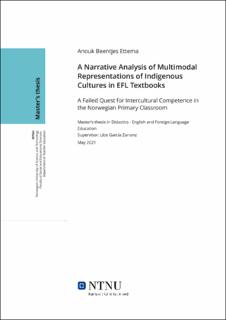| dc.contributor.advisor | Zarranz, Libe García | |
| dc.contributor.author | Ettema, Anouk Beentjes | |
| dc.date.accessioned | 2021-09-28T17:51:44Z | |
| dc.date.available | 2021-09-28T17:51:44Z | |
| dc.date.issued | 2021 | |
| dc.identifier | no.ntnu:inspera:76470736:14638133 | |
| dc.identifier.uri | https://hdl.handle.net/11250/2785126 | |
| dc.description.abstract | Formålet med denne masteroppgaven er todelt. Første del handler om å analysere hvordan urfolk og deres kulturer blir fremstilt i fire lærebøker i engelskfaget for 6. trinn i Norge. Andre del handler om hvordan disse fremstillingene er med på å fremme interkulturell kompetanse. I oppgaven ser jeg på urfolks teori og praksis, teoretiske tilnærminger til kultur, og fremstillinger av urfolk og deres kulturer. Læreverkene følger læreplanen fra 2006 (LK06) i engelsk. I 2019 ble det innført en ny læreplan (LK20), derfor har jeg analysert hvordan den tidligere og nye læreplanen vektlegger og inkludert kultur. Analysen er gjennomført ved å implementere en multimodal narrativ analyse, som inkluderer både strukturanalyse og visuell semiotisk analyse. Ved å bruke en multimodal narrativ analytisk tilnærming har man mulighet til å analysere hvem som blir fremstilt og på hvilken måte. Videre gir en narrativ tilnærming informasjon som hvem som har skrevet fortellingen og for hvilket formål.
Funnene avslører at det er en trend i lærebøkene som viser urfolk i en udefinert fortid for å representere urfolks kulturer. Lærebøkene representerer ikke mangfoldet av urfolks kulturer, ettersom mange av skildringene er stereotypiske og homogene. Denne studien konkluderer dermed at urfolk og deres kulturer blir fremstilt på en slik måte at de kan være med på å danne stereotypier hos elevene. Dette kan være med på å redusere elevenes interkulturelle kompetanse. Med dette i betraktning er det viktig at engelsklærere har en kritisk tilnærming til dette temaet og supplerer med andre læremidler. | |
| dc.description.abstract | The aim of this master’s thesis is twofold. Firstly, I examine how Indigenous cultures are represented in multimodal narratives across four English as a foreign language (EFL) textbooks developed for 6th grade in Norway. Secondly, I explore if and how these depictions foster intercultural competence. The thesis draws on Indigenous theorical approaches and theoretical approaches to culture, and representations of Indigenous cultures. The textbooks are based on the national curriculum 2006 (LK06), however, in 2019 a new national curriculum (LK20) was issued. I have therefore analysed how the previous and the new curriculum view and have implemented culture. The analysis was conducted by carrying out a multimodal narrative analysis that consists of a structural narrative analysis and visual semiotic analysis. Applying a narrative analysis offers an opportunity to examine who is portrayed and how they are depicted. Furthermore, a narrative approach provides information such as who has written the narrative and for what purpose. The findings reveal that there is a trend in the textbooks portraying Indigenous people in an undefined past and de-historicized way. The textbooks also fail to represent the diversity of Indigenous cultures, as many of the portrayals are simplistic and homogeneous. Consequently, the study concludes that the multimodal representations of Indigenous cultures generally reproduce stereotypes, which decreases students’ intercultural competence. It is therefore important for teachers in the English subject to think critically about this topic and supplement textbooks with other materials. | |
| dc.language | eng | |
| dc.publisher | NTNU | |
| dc.title | A Narrative Analysis of Multimodal Representations of Indigenous Cultures in EFL Textbooks:
A Failed Quest for Intercultural Competence in the Norwegian Primary Classroom | |
| dc.type | Master thesis | |
